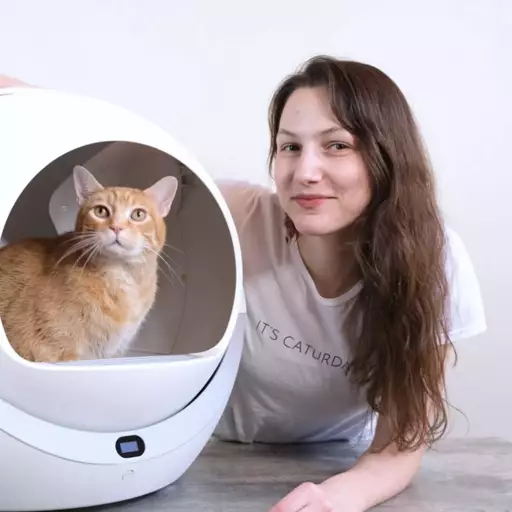The Best Non-Prescription Cat Food for Urinary Crystals : 8 Healthy Alternatives To Vet-Prescribed Diets
Quick Guide
- What Is The Best Cat Food for Urinary Crystals?
- What are Urinary Crystals In Cats?
- Understanding Urinary Crystals in Cats
- Symptoms of Urinary Crystals in Cats?
- What to look for in a good cat food for urinary crystals
- How to Transition Your Cat to a New Diet
- Other Lifestyle Changes to Support Urinary Health in Cats
- Frequently Asked Questions
- What causes urinary crystals in cats?
- What is the best food to prevent urinary crystals in cats?
- Can a diet change resolve my cat’s urinary crystal problem?
- Can I feed my cat regular cat food if it has urinary crystals?
- Are there any natural foods that can help prevent urinary crystals in cats?
- How long does it take for a change in diet to affect urinary crystals?
- Is dry food bad for cats with urinary crystals?
- Is there any cat breed more prone to developing urinary crystals?
- RECAP : The Top Non-Prescription Cat Foods for Urinary Crystals
- Conclusion
- References
If you’re concerned about your cats’ urinary health then you’ll be happy to know that there’s good news. Urinary crystals in cats can be managed and even prevented with an appropriate diet and adequate hydration.
The food you feed your cat plays a significant role in managing and preventing urinary crystals. Certain foods can contribute to an environment in the urinary tract that allows crystals to form. For example, diets high in magnesium and phosphorus can contribute to the formation of struvite crystals1.
Conversely, a well-balanced diet can help prevent crystal formation by promoting a more neutral pH in the urine and providing sufficient hydration2. Additionally, diets high in animal-based protein can help maintain a healthier urinary environment for your cat3.
In this article, we’re going to explore the best non-prescription cat food for urinary crystals.
What Is The Best Cat Food for Urinary Crystals?
Smalls Smooth Cow Human-Grade Fresh Cat Food
A wet food with high quality protein is essential for cats with urinary crystals and Smalls is one of the only companies making human-grade recipes with nutritionally intact meats. This beef formula contains the lowest amounts of phosphorus and sodium of any of their product-line and is nutritionally balanced with fresh vegetables and vitamins to support your ailing cat.
Average Price : Varies
Smalls Smooth Cow Human-Grade Fresh Cat Food
Beef, Beef liver, Green beans, Water (sufficient for processing), Spinach, Tricalcium phosphate, Peas, Choline chloride, Potassium chloride, Salt, Taurine, Magnesium sulfate, Niacinamide, Ferrous sulfate, Zinc sulfate, Vitamin E supplement, Thiamine mononitrate (vitamin B1), Calcium pantothenate (vitamin B5), Copper sulfate, Pyridoxine hydrochloride (vitamin B6), Manganese sulfate, Riboflavin (vitamin B2), Potassium iodide, Folic acid, Biotin (vitamin B7), Vitamin B12 supplement, Vitamin D3 supplement
Average Price : Varies
Average Price : Varies
Taste Of The Wild Rocky Mountain Grain-Free Canned Food
Most Popular Cat Food for Urinary Crystals: Taste of the Wild Rocky Mountain Grain-Free Canned Food is a popular choice for supporting your cat’s urinary health. Its high moisture content is crucial in promoting optimal hydration, which in turn aids in diluting the urine and encourages regular urination, both critical for preventing urinary crystal formation. The top-grade animal proteins such as salmon, chicken, and roasted venison contribute to balanced nutrition without the excessive minerals that can lead to crystal formation. Moreover, the natural ingredients like peas, tomatoes, and blueberries provide essential vitamins and antioxidants that promote overall health, including the urinary tract. Although not designed specifically for urinary health, its high-quality, grain-free formulation contributes to a balanced diet that can support your cat’s urinary health along with other facets of their wellbeing.
- Pros: Real animal proteins, rich in omega-3 fatty acids, high-quality natural ingredients, complete and balanced, rich in moisture and natural flavor, chelated mineral supplements
- Cons: May be too high in fiber or starch for some cats
What are Urinary Crystals In Cats?
Urinary crystals are solid deposits that can form in a cat’s bladder. They are usually made up of minerals like calcium, magnesium, phosphorus, or oxalates. If left untreated, these can lead to discomfort, urinary tract infections, and in severe cases, a potentially life-threatening condition called a urinary blockage4.
Understanding Urinary Crystals in Cats
Urinary crystals are microscopic mineral deposits that form in a cat’s urinary tract, typically the bladder. The two most common types of urinary crystals are struvite, which form in more alkaline urine, and calcium oxalate, which form in more acidic urine. Factors contributing to crystal formation can include the cat’s diet, hydration level, urinary pH, and even genetic predisposition.
What happens if my cat’s urinary crystals are left untreated?
The presence of urinary crystals in cats can lead to a range of issues, the most common of which is Feline Lower Urinary Tract Disease (FLUTD).
FLUTD is a broad term that encompasses conditions affecting the bladder and urethra, and it can be influenced by factors such as diet, stress, and water intake.
The formation of crystals can irritate the bladder lining, causing discomfort and potentially leading to urinary tract infections. Moreover, if these crystals aggregate to form larger stones, or uroliths, they can cause more significant issues, including urinary blockages, particularly in male cats. This is a life-threatening emergency requiring immediate veterinary care.
Management and Prevention
Management and prevention of urinary crystals primarily revolve around dietary modifications and increasing water intake.
A proper diet can control the levels of certain minerals in the cat’s diet, maintain a healthy urinary pH, and increase the frequency of urination, thereby reducing the chances of crystal formation.
Moreover, veterinary diets are available that are specifically designed to manage urinary crystals and stones. Hydration is also critical in maintaining urinary health, as it promotes dilute urine and more frequent urination, helping to flush out any crystals.
Ensuring that your cat has fresh, clean water available at all times, and feeding canned or wet food can greatly increase their water intake. Regular vet check-ups are also crucial in the early detection and management of urinary crystals and related conditions.
Symptoms of Urinary Crystals in Cats?
Urinary crystals in cats can lead to a condition called Feline Lower Urinary Tract Disease (FLUTD), and can cause a range of symptoms including:
- Frequent Attempts to Urinate: Cats with urinary crystals often make frequent trips to the litter box, but may only produce small amounts of urine.
- Straining to Urinate: The presence of crystals can cause discomfort or pain, which may be noticeable as straining when trying to urinate.
- Blood in the Urine (Hematuria): This can be visible as a pink or red tinge to the urine, or may only be detectable under microscopic examination.
- Urinating Outside the Litter Box: Cats may associate the pain of urination with the litter box and start urinating in inappropriate places.
- Excessive Licking of the Genital Area: Cats may excessively lick their genital area due to discomfort or irritation5.
- Changes in Behavior: This can include aggression, lethargy, or changes in eating or drinking habits.
- Crying or Vocalizing While Urinating: Cats may cry out or vocalize due to pain or discomfort while urinating.
What to look for in a good cat food for urinary crystals
- Balanced pH: One of the key features of a diet designed to prevent or treat urinary crystals in cats is its ability to promote a balanced pH in the urine. Different types of crystals form under different pH conditions, so a diet that maintains a healthy pH balance is critical. Struvite crystals, for instance, are more likely to form in alkaline urine, while calcium oxalate crystals are more likely to form in acidic urine.
- Low in Magnesium, Phosphorus, and Calcium: These minerals can contribute to crystal formation in a cat’s urinary tract. Therefore, foods designed for urinary health often have controlled levels of these nutrients.
- High Moisture Content: Hydration is important in preventing urinary crystals, as it leads to dilute urine and encourages regular urination, helping to flush out any crystals that might be forming. Wet or canned foods typically have higher moisture content than dry foods.
- Protein Source: High-quality protein is important in a cat’s diet. However, the source of the protein is key in urinary health. Animal-based proteins are typically preferred, as they are more biologically available to cats and tend to produce less ash and magnesium when metabolized, which are contributors to struvite crystal formation.
- Added Nutritional Supplements: Some cat foods are fortified with nutrients like potassium citrate that can help to manage urinary pH. Other diets may contain glucosamine and chondroitin sulfate, compounds that can help to protect the bladder lining.
When searching for cat food that supports urinary health, there are several key components to consider. The food should have balanced levels of minerals, particularly being low in magnesium and phosphorus6.
Adequate hydration is another crucial factor. Wet foods can help increase your cat’s water intake, which dilutes the urine and decreases the risk of crystal formation7.
High-quality protein is another essential component. The protein should ideally come from animal sources, as they have the correct balance of amino acids necessary for cats8. Foods should also avoid unnecessary fillers and artificial additives.
How to Transition Your Cat to a New Diet
It’s essential to introduce a new diet gradually to avoid upsetting your cat’s digestive system. Start by mixing a small amount of the new food with your cat’s current food, slowly increasing the proportion over a week or two9.
Monitor your cat’s response to the diet change. If you notice any adverse reactions like vomiting, diarrhea, or loss of appetite, consult your vet immediately10.
Other Lifestyle Changes to Support Urinary Health in Cats
Regular veterinary check-ups can help catch any urinary issues in their early stages. Encouraging hydration, perhaps by providing a cat water fountain, can be beneficial. Also, providing a stress-free environment, regular exercise, and maintaining a healthy weight are vital aspects of overall and urinary health11.
Frequently Asked Questions
What causes urinary crystals in cats?
Urinary crystals in cats are often caused by a number of factors including dehydration, urinary tract infections, dietary issues, and genetic predispositions. An imbalance in the pH of the cat’s urine can lead to the formation of crystals.
What is the best food to prevent urinary crystals in cats?
The best food for cats with urinary crystals is typically one that promotes a healthy pH in their urine, has low magnesium levels, is high in moisture, and encourages frequent urination. Prescription diets specifically formulated for urinary health, such as Hill’s Prescription Diet c/d or Royal Canin Urinary SO, are often recommended by veterinarians.
Can a diet change resolve my cat’s urinary crystal problem?
While a diet change alone may not be enough to resolve all urinary crystal issues, it can play a significant role in management and prevention. In combination with adequate hydration, a proper diet can help maintain the urinary tract health in cats.
Can I feed my cat regular cat food if it has urinary crystals?
If your cat has been diagnosed with urinary crystals, it’s crucial to discuss dietary needs with your vet. They may recommend a specific diet to help manage the condition. Feeding regular cat food without considering the mineral content and pH effect might lead to worsening of the condition.
Are there any natural foods that can help prevent urinary crystals in cats?
Natural foods can contribute to a healthy diet for a cat with urinary crystals. Foods high in moisture, like wet food or even raw food diets, can help prevent crystals by promoting hydration and more frequent urination. However, it is vital to consult with a vet before making any major changes to your cat’s diet.
How long does it take for a change in diet to affect urinary crystals?
This largely depends on the individual cat and the severity of the crystal formation. In some cases, a change in diet can lead to improvements within a few weeks. However, it’s important to follow up with your vet for regular urinalysis to monitor progress.
Is dry food bad for cats with urinary crystals?
Dry food can contribute to dehydration in cats, which may worsen urinary crystal conditions. Many vets recommend canned or wet food diets for cats with urinary health issues, as they help to increase overall fluid intake and promote healthier urinary function.
Is there any cat breed more prone to developing urinary crystals?
While urinary crystals can develop in any cat, certain breeds such as the Persian, Himalayan, and British Shorthair are genetically more predisposed to urinary tract issues.
RECAP : The Top Non-Prescription Cat Foods for Urinary Crystals
Conclusion
Urinary crystal formation is a common health issue in cats that can be managed and prevented through dietary changes. If you decide to go the non-prescription route it’s crucial to select high-quality, cat food that promotes urinary health and couple this with other lifestyle modifications to keep your feline friend in the best health possible.
References
- Lulich, J. P., Osborne, C. A., & Bartges, J. W. (2016). ACVIM small animal consensus recommendations on the treatment and prevention of uroliths in dogs and cats. Journal of Veterinary Internal Medicine, 30(5), 1564-1574.
- Dijcker, J. C., Plantinga, E. A., van Baal, J., & Hendriks, W. H. (2011). Influence of nutrition on feline calcium oxalate urolithiasis with emphasis on endogenous oxalate synthesis. Nutrition research reviews, 24(1), 96-110.
- National Research Council. (2006). Nutrient Requirements of Dogs and Cats. The National Academies Press.
- Cornell University, College of Veterinary Medicine. (n.d.). Feline Lower Urinary Tract Disease.
- American Veterinary Medical Association. (n.d.). Urinary problems in cats.
- Bartges, J. W. (2012). Chronic kidney disease in dogs and cats. Veterinary Clinics: Small Animal Practice, 42(4), 669-692.
- Markwell, P. J., Buffington, C. A., Chew, D. J., Kendall, M. S., Harte, J. G., & Dibartola, S. P. (1999). Clinical evaluation of commercially available urinary acidification diets in the management of idiopathic cystitis in cats. Journal of the American Veterinary Medical Association, 214(3), 361-365.
- Zoran, D. L. (2002). The carnivore connection to nutrition in cats. Journal of the American Veterinary Medical Association, 221(11), 1559-1567.
- Westropp, J. L., & Buffington, C. A. (2004). Feline idiopathic cystitis: current understanding of pathophysiology and management. Veterinary Clinics: Small Animal Practice, 34(4), 1043-1055.
- Cornell University, College of Veterinary Medicine. (n.d.). Transitioning Your Cat to a New Food.
- Buffington, C. A., Westropp, J. L., Chew, D. J., & Bolus, R. R. (2006). Clinical evaluation of multimodal environmental modification (MEMO) in the management of cats with idiopathic cystitis. Journal of feline medicine and surgery, 8(4), 261-268.











